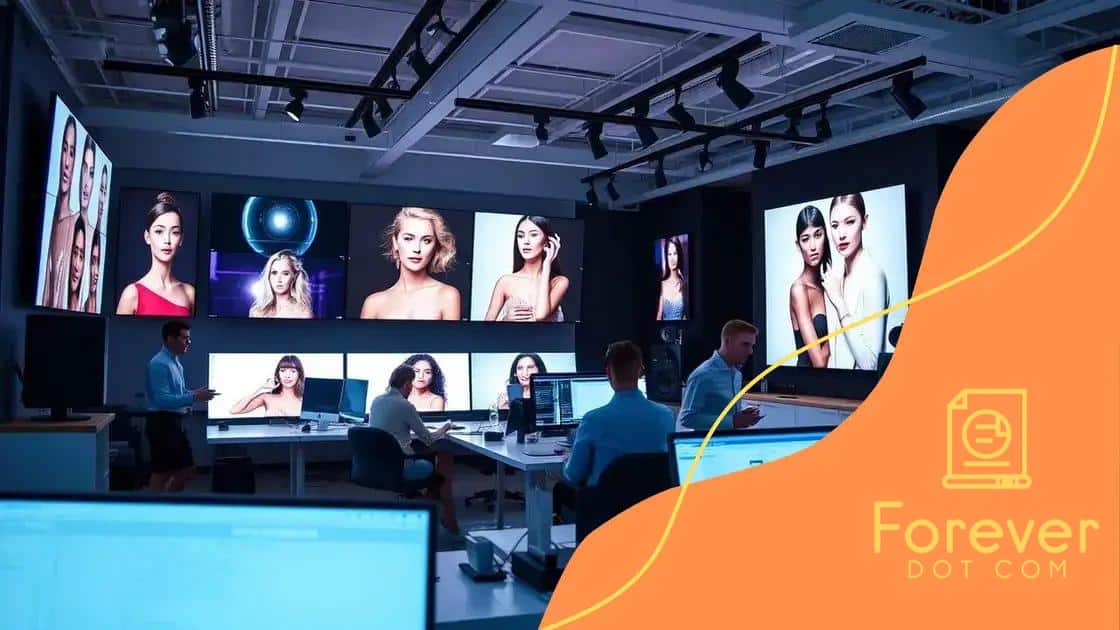How modeling agencies are adapting to digital trends

Modeling agencies are adapting to digital trends by leveraging social media for talent discovery, utilizing virtual reality in auditions, collaborating with influencers, and employing data-driven decision-making to meet changing consumer preferences.
How modeling agencies are adapting to digital trends is reshaping the industry. With platforms evolving rapidly, agencies must embrace innovative approaches to remain relevant and competitive. What strategies are they using? Let’s explore.
Embracing social media for talent discovery
Social media has revolutionized talent discovery in the modeling industry. Agencies are recognizing the potential of platforms like Instagram and TikTok to find and connect with new models.
Through these platforms, agencies now have direct access to a diverse pool of aspiring talent. The ease of sharing content allows even those without traditional portfolios to showcase their potential. This shift is providing opportunities to individuals who might not have been spotted through conventional methods.
Key Benefits of Social Media for Talent Discovery
- Broader Reach: Social media allows agencies to discover talent from various geographical locations.
- Authentic Engagement: Real-time interaction helps agencies gauge a model’s personality and audience connection.
- Quick Feedback: Responses from followers and industry professionals can guide talent selection.
- Cost-Effective Marketing: Agencies can promote castings or model showcases without the high costs of traditional advertising.
Moreover, the engaging format of social media fosters creativity. Models can present themselves uniquely through videos or stories, painting a dynamic picture of who they are. Additionally, platforms often provide tools that help enhance visibility, such as hashtags and trending challenges.
For example, when models participate in trending challenges, they can gain followers rapidly. This can lead to increased visibility, allowing modeling agencies to pick up on who has the potential to captivate audiences. As agencies embrace these trends, staying ahead in a competitive market becomes increasingly achievable.
In summary, leveraging social media for talent discovery is transforming how modeling agencies operate. By adapting to these platforms, agencies not only discover fresh talent but also engage with their audience actively. This dynamic relationship nurtures a thriving community around the modeling industry.
Utilizing virtual reality in auditions
Utilizing virtual reality (VR) in auditions is becoming a game changer for modeling agencies. This technology allows for a more immersive experience for both models and agencies, enhancing the traditional audition process.
With VR, models can showcase their skills in realistic environments, simulating actual photoshoots or runway shows. This helps agencies see how candidates perform under pressure and in various settings, providing valuable insight that was hard to gauge in conventional auditions.
Benefits of Virtual Reality in Auditions
- Realistic Scenarios: Models can experience lifelike situations, giving agencies a better perspective on their abilities.
- Safety and Convenience: Potential models can audition from the comfort of their homes, reducing travel time and costs.
- Engagement: The excitement of VR can attract more talent, as it offers a unique way to showcase skills.
- Customization: Agencies can tailor VR experiences to reflect specific casting requirements, ensuring candidates fit the model’s needs.
As the technology evolves, many agencies are exploring innovative ways to integrate VR into their processes. For instance, they are designing specific environments that replicate high-fashion settings or casual lifestyle shoots, giving models the chance to adapt their performances.
Moreover, the feedback gained from these VR sessions can be immediate, allowing agencies to provide quicker responses to aspiring models. This keeps the application cycle moving smoothly, benefiting both parties. As more agencies adopt VR, it is clear that this technology is not just a trend, but rather a significant step forward in how models are evaluated.
This shift towards virtual reality in auditions opens doors for inclusivity and creativity within the industry. It embraces new talent while encouraging agencies to rethink how they scout for models.
The rise of influencer collaborations

The rise of influencer collaborations is transforming how modeling agencies connect with their audience. By teaming up with popular influencers, agencies can reach broader demographics and engage potential clients effectively.
Influencers have become powerful figures in the fashion industry. They offer models a way to showcase their skills through established platforms with large followings. This shift creates an organic way for brands to promote their products while providing models with valuable exposure.
Advantages of Collaborating with Influencers
- Increased Visibility: Influencers can highlight models on their channels, leading to greater audience reach.
- Authentic Engagement: Followers trust influencers, which can result in more authentic interactions compared to traditional advertising.
- Access to Niche Markets: Collaborations can target specific groups, expanding the potential client base.
- Enhanced Brand Image: Associating with influencers can elevate a model’s or agency’s image, aligning them with trendsetters.
Moreover, influencer collaborations allow modeling agencies to navigate the fast-paced digital landscape. With social media, trends can shift rapidly, and working with influencers enables agencies to stay agile and responsive. They can quickly pivot strategies based on what is currently resonating with audiences.
As more influencers enter the space, diversity in representation also flourishes. Collaborating with influencers from various backgrounds helps agencies showcase different styles and perspectives, making the industry more inclusive. This trend is not just about getting models noticed; it’s about fostering a community that resonates with consumers.
In summary, the emergence of influencer collaborations signifies a new approach to modeling and marketing. By utilizing these partnerships, agencies can enhance their visibility, connect with audiences more authentically, and contribute to a more diverse industry landscape.
Data-driven decision-making in modeling
Data-driven decision-making in modeling is reshaping how agencies operate. By leveraging data analytics, agencies can make informed choices that enhance their business strategies and improve outcomes.
This approach allows agencies to collect and analyze various metrics, including audience engagement, model performance, and market trends. With concrete data, agencies can tailor their casting choices and marketing efforts more effectively.
Importance of Data Analytics in Modeling
- Enhanced Talent Selection: Agencies can use data to identify models who resonate with specific demographics.
- Trend Prediction: By tracking performance metrics, agencies can anticipate which styles or looks will gain popularity.
- Optimized Marketing Strategies: Agencies can refine their outreach efforts based on analytics, maximizing engagement and minimizing waste.
- Improved Client Satisfaction: Data insights allow for a better understanding of clients’ needs, leading to stronger relationships.
Moreover, utilizing data helps modeling agencies stay competitive. In an industry driven by trends, having access to real-time data provides a clear advantage. Agencies can quickly adjust their strategies based on the performance of past campaigns or the behaviors of target audiences.
For instance, if certain models consistently perform well on social media, this data can drive future casting decisions. Likewise, if a specific type of content generates more engagement, agencies can shift their focus toward those styles and looks.
As technology continues to evolve, the capacity to analyze data will only improve. This means agencies will increasingly rely on data-driven insights for successful modeling, tailoring their approaches to meet the changing needs of both models and clients. The shift toward data-driven decision-making is not merely a trend; it’s an essential element for thriving in the modern modeling industry.
Adapting to changing consumer preferences
Adapting to changing consumer preferences is crucial for modeling agencies looking to thrive in a competitive landscape. As trends evolve rapidly, agencies must stay informed about what influences audience decisions.
Today’s consumers are more informed and have diverse tastes. This means they seek more than just traditional beauty; they want authenticity and representation. Agencies that recognize these shifts can cater to a wider array of clients, emphasizing inclusion and diversity.
Strategies for Adapting to Consumer Preferences
- Market Research: Regularly conducting research helps agencies understand emerging trends and consumer needs.
- Flexible Casting: Embracing models of various backgrounds expands the appeal to different consumer segments.
- Feedback Mechanisms: Gathering feedback from clients and consumers can guide agencies in their choices and strategies.
- Social Media Trends: Keeping an eye on social media can reveal insights about preferences and styles that resonate with audiences.
Furthermore, modern consumers often prefer brands that align with their values. This underscores the importance of showcasing models who reflect different identities, body types, and lifestyles. By doing so, agencies not only attract a broader audience but also foster strong connections with consumers who appreciate authenticity.
As agencies adopt these strategies, they create more engaging experiences, leading to increased loyalty from clients and consumers alike. For instance, brands that champion social causes or environmental sustainability can resonate deeply with today’s conscious consumers.
In summary, staying ahead of changing consumer preferences allows modeling agencies to be proactive rather than reactive. By adapting to these shifts, they can build a strong and relatable brand that meets the needs of an increasingly diverse audience.
FAQ – Frequently Asked Questions About Modeling Agencies and Digital Trends
How are modeling agencies using social media for talent discovery?
Modeling agencies are leveraging social media platforms like Instagram and TikTok to find and connect with new talent more effectively.
What role does virtual reality play in modern auditions?
Virtual reality transforms auditions by providing immersive experiences where models can showcase their skills in realistic settings, enhancing the evaluation process.
How can agencies stay relevant to changing consumer preferences?
Agencies can stay relevant by conducting regular market research, adapting to consumer trends, and engaging with diverse talent that reflects audience values.
Why is data-driven decision-making important for modeling agencies?
Data-driven decision-making allows agencies to make informed choices based on metrics and analytics, leading to better talent selection and marketing strategies.






